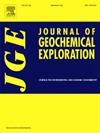Recycled mantle source for porphyry mineralization: U−Pb and Re−Os geochronology, and S–Pb–Cu isotopic constraints from the Urumieh-Dokhtar magmatic arc, central Iran
IF 3.4
2区 地球科学
Q1 GEOCHEMISTRY & GEOPHYSICS
引用次数: 0
Abstract
The Urumieh−Dokhtar magmatic arc (UDMA) hosts some of the world-class porphyry copper deposits in Iran. Here, we present high-resolution geochronological and stable isotope data to gain insights into the timing and source of the metallogeny of Kahang porphyry Cu deposit. Zircon U−Pb data show crystallization age of ca. 15 Ma age for the host porphyry intrusion and Re−Os geochronology yields 14.5 Ma from the molybdenite associated with the ores. Sulfur isotope values on the sulphide minerals range from −1.6 ‰ to + 2.1 ‰, indicating a magmatic source for sulfur. Lead isotopic compositions of the S-bearing minerals are akin to those of the intrusive rocks, suggesting that the metal was likely sourced from mantle reservoirs. We propose a model for the UDMA involving slab break-off during the maturity of arc magmatism from the syn- to post-collisional stages of orogenesis. The δ65Cu data trace a systematic change from the barren to the fertile magmas. We suggest that partial melting of the sub-continental lithospheric mantle that has previously been refertilized of Cu through time as the potential source for the formation of ore-bearing magmas.
斑岩矿化的再生地幔源:伊朗中部乌鲁米耶-多赫塔尔岩浆弧的 U-Pb 和 Re-Os 地质年代以及 S-Pb-Cu 同位素制约因素
乌鲁米耶-多赫塔尔岩浆弧(UDMA)是伊朗一些世界级斑岩铜矿床的所在地。在此,我们展示了高分辨率的地质年代和稳定同位素数据,以深入了解 Kahang 斑岩铜矿床的成矿时间和来源。锆石 U-Pb 数据显示,主斑岩侵入体的结晶年龄约为 15 Ma,而与矿石相关的辉钼矿的 Re-Os 地质年代为 14.5 Ma。硫化物矿物的硫同位素值在 -1.6 ‰ 至 + 2.1 ‰ 之间,表明硫的来源于岩浆。含硫矿物的铅同位素组成与侵入岩相似,表明金属可能来自地幔储层。我们为UDMA提出了一个模型,该模型涉及从造山运动的同步阶段到碰撞后阶段的弧岩浆成熟过程中的板块断裂。δ65Cu数据追踪了从贫瘠岩浆到肥沃岩浆的系统变化。我们认为,大陆下岩石圈地幔的部分熔融是含矿岩浆形成的潜在来源,而这些地幔在之前的时间里已经补充了Cu。
本文章由计算机程序翻译,如有差异,请以英文原文为准。
求助全文
约1分钟内获得全文
求助全文
来源期刊

Journal of Geochemical Exploration
地学-地球化学与地球物理
CiteScore
7.40
自引率
7.70%
发文量
148
审稿时长
8.1 months
期刊介绍:
Journal of Geochemical Exploration is mostly dedicated to publication of original studies in exploration and environmental geochemistry and related topics.
Contributions considered of prevalent interest for the journal include researches based on the application of innovative methods to:
define the genesis and the evolution of mineral deposits including transfer of elements in large-scale mineralized areas.
analyze complex systems at the boundaries between bio-geochemistry, metal transport and mineral accumulation.
evaluate effects of historical mining activities on the surface environment.
trace pollutant sources and define their fate and transport models in the near-surface and surface environments involving solid, fluid and aerial matrices.
assess and quantify natural and technogenic radioactivity in the environment.
determine geochemical anomalies and set baseline reference values using compositional data analysis, multivariate statistics and geo-spatial analysis.
assess the impacts of anthropogenic contamination on ecosystems and human health at local and regional scale to prioritize and classify risks through deterministic and stochastic approaches.
Papers dedicated to the presentation of newly developed methods in analytical geochemistry to be applied in the field or in laboratory are also within the topics of interest for the journal.
 求助内容:
求助内容: 应助结果提醒方式:
应助结果提醒方式:


